Warts are formations on the skin and mucous membranes of benign nature that occur due to activation of the human papillomavirus.
They do not look aesthetically pleasing and often cause complexes. A person wants to get rid of them but does not know how.
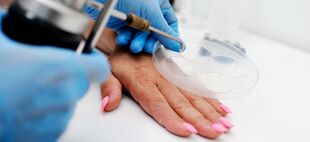
Should we remove the build?
It depends on the size of the papillomas, their nature and the age of the person. But more often than not, the answer is unequivocally positive because warts are contagious and can be transmitted to others. Perhaps self-infection is also autoinoculation.
Firstly, the infectivity of neoplasms manifests itself not only through direct contact with them, but also when using ordinary household items, personal hygiene items or simply touching places where an infected person touched. For example, a bus railing.
Secondthe location of the wart may be in a place that is most likely to be damaged - neck, feet, armpits, groin. These places are more often than others rubbing with clothes, hugs and touches. Then it is filled with malignancy, bleeding, growth.
Thirdlyformations can increase in size and number, this causes aesthetic problems. This phenomenon can be called conquest of territory by a wart.
Important! Not always, but perhaps degeneration of a wart to melanoma, an incurably aggressive skin cancer.
Major misunderstandings about the danger of surgery
Early treatment and treatment of warts is the best solution. It saves you a lot of time, effort and money. Although 70% of warts can spontaneously disappear after two years of existence, they can return with the same success and also to new places.
Fear for many when contacting the surgeon is associated with fear of the surgery, its complications, relapse and possible pain during the procedure. They are completely unfounded as modern methods provide very good pain relief and many do not require anesthesia at all.
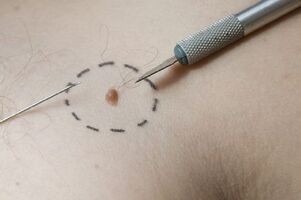
There is still a widespread belief that an extra touch of a wart with a surgical knife will increase its growth. This is the deepest misconception - it is the surgical procedure that prevents the spread of the virus and prevents the wart from growing. Fortunately, there are enough methods for this.
Strange can be called those patients who are not afraid to use traditional home-grown methods and refuse qualified help. A doctor's experience and qualifications are of course crucial, but a good surgeon is not uncommon.
And one more help - do not trust beauticians and run to them with warts. They just do not have adequate medical education.
Modern methods
There are newer or older removal methods. Each of them has its own advantages and disadvantages. In addition, the effect of wart size, its position and depth depends on the growth.
All methods can be grouped into 3 groups: hardware, surgical and chemical. Alternative treatment is more related to the method of physical (mechanical) influence.
When contacting the doctor, the doctor may, in his opinion, recommend the best solution, but the final choice is made by the patient himself.
An initial consultation is also necessary because not all the methods chosen may be suitable as there are contraindications and limitations.
Laser treatment
The laser method can be called universal. Among all methods, he is at the forefront today. Using a laser, you can remove warts in the most difficult, delicate and painful places. It is also beneficial as it does not give scars. The beam is the safest and least traumatic.
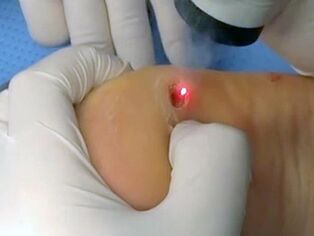
The efficiency is so high that one procedure is enough. The essence of the thermal effect on the wart burns with temperature. Healing is fast without scars and complications.
More laser pluses:
- the patient does not feel pain;
- no anesthesia required;
- complete removal;
- fast - takes 1-2 minutes. Relapses are only possible in 20% of cases.
Burning leaves a fossa that heals in 2 weeks. The skin may lighten temporarily, which also disappears on its own after 3 weeks.
Cauterization with liquid nitrogen
Cryodestruction is the freezing of a wart by the low temperature method using liquid nitrogen. Duration - 30 seconds. Freezing leads to the death of growth tissue. When exposed to freezing, the papilloma thickens and turns white. After a minute, she turns red and swells.
A bubble with gray liquid appears at home. In a week it breaks through on its own and a crust forms. The crust heals and falls off in 2 weeks.
There is a pink spot left, gradually the color becomes equal to the skin. The formation disappears within 2 weeks and a pink spot appears at the site of removal, which gradually disappears.
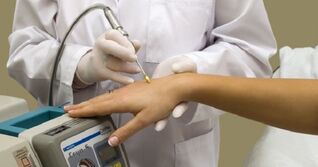
Benefits:
- no pain, no scarring and no anesthesia required;
- no infection or bleeding.
The only drawback is that there is no way to control the depth of the shock.
On the soles of the feet, the shock lasts approx. 1 minute. The procedure can be repeated on the sole up to 5 times. Minus - long wound healing.
Electrocoagulation
Electrocoagulation for warts uses high frequency currents. It concentrates in a loop that cuts off the wart. The moxibustion temperature is approx. 80 degrees.
No bleeding due to concomitant coagulation of blood vessels. Local anesthesia is required. A big plus of the method is that it prevents the virus from spreading further. In addition, the method is quite budget-friendly and efficient.
The surrounding tissue must be covered and the skin disinfected. There is also a crust stage. It disappears within a week. After this, an almost imperceptible, transparent scar remains, but more often a light spot. There is no relapse!
Using radio wave therapy
The method is considered to be no less efficient than electric current. Moxibustion is performed using special devices, a doctor will help you choose the right one. This is a radio wave generator, its high frequency electric waves do not touch the wart, but cut it off completely.
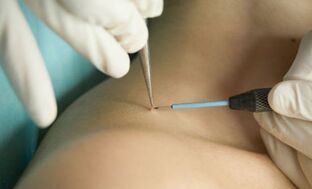
The essence of the action is that the cells of the wart contain fluid that expands with radio waves, the wart swells and bursts. The work is performed with a special tip that looks like a ballpoint pen.
There are no scars or infections. The only drawback is that the procedure is painful, because of this the accumulation is pre-lubricated with an anesthetic. Healthy cells are not damaged. Moxibustion lasts about 20 minutes.
Advice! At the crust stage, it can not be moistened and peeled off! She's gone in a week.
Surgical excision
Surgical removal is a traditional, classical method performed with a scalpel. It is not used often now. The method is traumatic and produces relapses, scars.
There is a risk of damage to adjacent tissues, the possibility of infection. But it is irreplaceable if the wart is large. Under local anesthesia with a special spoon after the incision, the wart is scraped out. The seams are cosmetic, they are removed after a week. The scar remains approx. 3 mm large, it fades over time.
Chemical moxibustion
The formation is affected with an acid or alkali. After a while, wash off. There are usually at least 6 procedures to achieve the effect. There is a burning sensation or tingling sensation beneath it. The wart dries up and falls off.

Disadvantages:
- there is a risk of further spread of the virus and infection is not excluded;
- healthy tissue is often damaged;
- scars are possible, healing takes about 10 days.
The method is only used if other methods are impossible.
Advantages and disadvantages of different methods, which is better
Every removal method has its advantages and disadvantages, there are no ideal options. Today, the most popular methods are: laser therapy, cryotherapy, electrocautery, radio waves, a surgical scalpel - in descending order of frequency of use. The cost of the first 3 methods is actually in the same price range.
The laser is the first to lead: there are no inaccessible places for it, it is safe, fast and painless. Cryodestruction is considered the second most effective, but with it there is no possibility to control the depth of exposure, which causes relapse.
And one more conclusion - the laser can only remove 1 small formation in 1 session.
Cryotherapy can be used for papillomatosis when up to 40 growths can be removed in one procedure. But here the doctor's experience is of great importance for quality.
How does the location and type of growth affect the choice of technique?
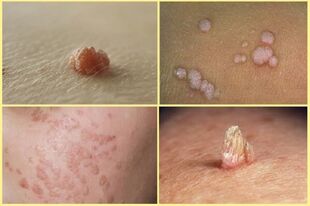
There are 4 types of warts:
- vulgar- in the form of small nodules often grow on fingers and toes, the back of the hands;
- flat- typically for young people they are in the form of protruding spots; these include plantar (thorns);
- thread-like (acrochords)- elastic thin outgrowths on the leg, appearing on the face (eyelids, lips) and neck;
- genital warts - often localized on the mucous membranes of the genitals in appearance.
These 4 types are of viral origin and belong to true warts.
But there are also senile keratomas, which are due to functional disorders of the skin. They do not require treatment, only observation. Cryotherapy can be used if desired.
The doctor recommends a method of removal, but ultimately the patient chooses. How the choice of method depends on the wart: small formations can be safely removed withradio wave "knife" or liquid nitrogen
Radio knifecan be used on face and neck, feet and palms, groin. With papillomas on the eyelids, it is not used. They can use a laser or liquid nitrogen.
Freezingis also used on arms and feet (on the sole), papillomas on the neck. The cryo method can be called universal. That is for sure.
Laser- removes all warts on any part of the body, including under the nail.
Surgical methodis used for large growths on the oral mucosa.
Electrocoagulationis recommended for flat and vulgar warts. Can even be applied to the face. With large formations, the effect is negligible. The electric knife is also not used for plantar warts because they usually have deep roots and are very dense.
Important! It is only advisable to remove plantar growth in a hospital.
The chemical method gives good results in plantar lesions, flat and pointed. Physical methods are ineffective in comparison to that.
What method of removing formations do doctors recommend?
Of course, the client chooses according to his abilities. But he must be guided by the doctor's opinion to the right decision. Specialists prefer complex (combined) treatment of warts, where the leading site belongs to the removal.
In addition, treatment will include oral administration of drugs with antiviral activity. Although the HPV (human papillomavirus) virus has not been cured 100%, in many respects activation of the state depends on immunity, it can be lowered, "put to sleep" and remission can be prolonged.
In addition to antiviral drugs, immune modulators are used for this purpose. This is primarily a group of interferons.
Doctors treat folk remedies without much enthusiasm, as the treatment is not performed by doctors and will be unsafe. It is fraught with damage to surrounding tissues, infection, inflammation. Children under 5 years of age should not remove warts in any way.














































































